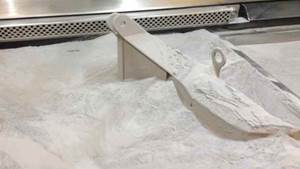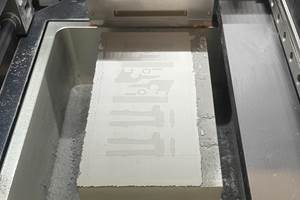Easing into AM
A layered approach to learning the technology behind additive manufacturing (AM) will help lessen the headaches.
So are you ready to take the plunge into additive manufacturing and start making complex, lightweight parts with incredible strength-to-weight ratios, or consolidated assemblies that minimize part count and provide superior functionality? Not so fast. AM is a lot harder than it might look, and diving into it headfirst can create more work and headache than benefit. I suggest easing your company into AM through “layered learning.”
Design Aids
The early days of AM were all about 3D printing design aids: prototypes, concept models and other visual examples that support product design and development. While many shops have moved on from this use of the technology, there are two key takeaways from using AM in this way: users become familiar with AM workflow, and they start to realize the limitations of AM processes. The former is helpful because this workflow—CAD, creating STL files, determining build orientation, slicing, toolpath planning—is necessary for every level of additive manufacturing; the design tools and level of detail just get more sophisticated as one progresses into more advanced AM use. And insight into some of the limitations of AM, such as layer height, overhang angles, thin walls, part warping and more, will continue to be useful in the more advanced stages of AM, beyond 3D printing with polymers.
Production Aids
Designing and printing production aids—jigs, fixtures and tooling—is the next “layer” of AM learning. This may be one of the least interesting applications of the technology, but it is probably the quickest way for a shop to realize a positive return on its investment in any additive system. For instance, a small, desktop 3D printer can easily pay for itself in one to three months if it is used to 3D-print fixtures and jigs that save time, increase efficiency and avoid other costs. The workflow is the same as that required for printing design aids, but it further challenges the user to think more creatively, a critical step for successful transition to more advanced AM.
Early successes will also help increase buy-in from others in the company, and may even be a way for shops to start saving for larger, more expensive AM systems.
Production aids will likely start out as direct replacements for existing jigs and fixtures, but eventually users will start designing more sophisticated and intricate tooling. Using AM for this purpose helps users build their confidence, get more comfortable working with the technology, and understand its pros and cons. Early successes will also help increase buy-in from others in the company, and may even be a way for shops to start saving for larger, more expensive AM systems. For example, a portion of the efficiency gains and/or cost savings could be directed to an AM “savings account” to support system upgrades or new AM technology purchases.
Part Production
After users have mastered the workflow, gained insight into AM’s process limitations and improved their creative confidence, they will be ready to start transitioning from polymer to metal AM systems and to shift into producing end-use parts. As with the printing of production aids, this will likely start with substitution of additively made parts for parts made by conventional production methods, which will allow companies to make apples-to-apples comparisons between those parts. Users will quickly realize that postprocessing AM parts (support removal, stress relief, heat treatment, hot isostatic pressing and finish machining, for example) will make them more costly to produce than the same parts with traditional manufacturing processes. At this point, users may start doubting their decision to move into AM. They need to keep in mind that subtractively manufactured parts were not designed for additive manufacture, and therefore direct replacement of a conventionally made part with an AM part is not likely to yield any cost benefits. In fact, as mentioned, it will likely be more expensive. In many cases, however, the part can be made faster through AM and/or require less tooling. That is main value proposition for additive manufacturing at this stage, and the economics become clearer to users as they shift into production with AM.
Design for AM
As much as users might love to jump directly to this most advanced stage of AM, layering the learning from the earlier stages is critical to success here. Knowing the workflow and economics of AM, combined with its process limitations and postprocessing challenges, provides the necessary insights for creative users to identify innovations that can only be enabled by AM. It is at this stage that generative design, lattice structures, topology optimization, internal and conformal cooling, and other sophisticated design tools can be exploited to their fullest to create superior-performing parts, consolidated assemblies and functionally graded materials. These AM innovations may be so revolutionary that they lead to disruptions in a company’s supply chain or other business units, which might create new opportunities for AM innovation. This is the beginning of a virtuous cycle that revolves around, and is enabled by, AM, and it is the reason why people are so excited about additive manufacturing.
But, take your time, keep learning, and eventually you will stack all the layers and become an expert in additive manufacturing who can utilize the full potential of the technology.
This article originally appeared in Additive Insights, a monthly column in Modern Machine Shop magazine.
Related Content
How to Organize for Additive Production: AM Radio #42
Tim Simpson and Peter Zelinski discuss the next steps for succeeding with AM: After technical and process successes come the cultural, organizational and even costing considerations associated with this mode of manufacturing.
Read MorePostprocessing Steps and Costs for Metal 3D Printing
When your metal part is done 3D printing, you just pull it out of the machine and start using it, right? Not exactly.
Read MoreAM 101: What Is Binder Jetting? (Includes Video)
Binder jetting requires no support structures, is accurate and repeatable, and is said to eliminate dimensional distortion problems common in some high-heat 3D technologies. Here is a look at how binder jetting works and its benefits for additive manufacturing.
Read More8 Cool Parts From Formnext 2023: The Cool Parts Show #65
New additive manufacturing technologies on display at Formnext were in many cases producing notable end-use components. Here are some of the coolest parts we found at this year’s show.
Read MoreRead Next
Alquist 3D Looks Toward a Carbon-Sequestering Future with 3D Printed Infrastructure
The Colorado startup aims to reduce the carbon footprint of new buildings, homes and city infrastructure with robotic 3D printing and a specialized geopolymer material.
Read MoreProfilometry-Based Indentation Plastometry (PIP) as an Alternative to Standard Tensile Testing
UK-based Plastometrex offers a benchtop testing device utilizing PIP to quickly and easily analyze the yield strength, tensile strength and uniform elongation of samples and even printed parts. The solution is particularly useful for additive manufacturing.
Read More3D Printed Polymer EOAT Increases Safety of Cobots
Contract manufacturer Anubis 3D applies polymer 3D printing processes to manufacture cobot tooling that is lightweight, smooth and safer for human interaction.
Read More





















